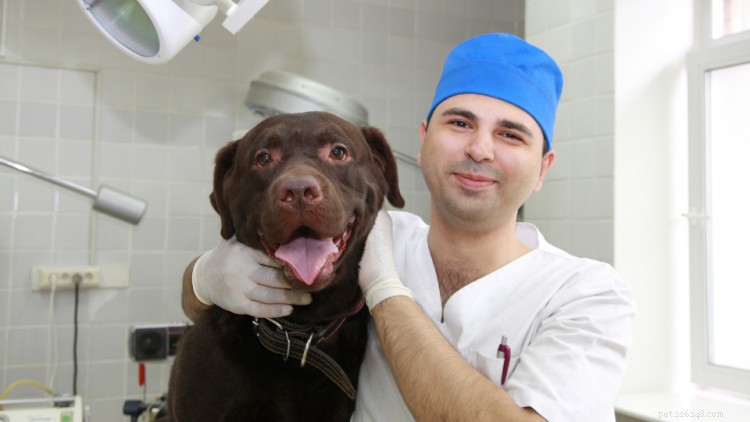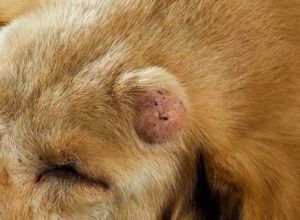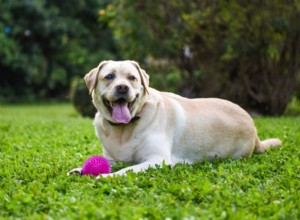犬の首、胸、脚、または背中にしこりが一晩で現れた場合は、パニックにならないでください。多くのペットの親は、自分の犬が癌にかかっているのではないかと恐れていますが、最悪のシナリオに飛びつく前に、獣医に予約して、しこりを評価してもらいましょう。脂肪腫の可能性があります。
脂肪腫は一般的なタイプの腫瘍で、約 16% の犬に影響を与えます。 . 「腫瘍」という言葉は恐ろしく聞こえるかもしれませんが、これらの異常な増殖は良性の脂肪の蓄積であり、通常は無害であることを知っておくことが重要です.
この記事では、犬の脂肪腫、除去費用、治療方法などについて知っておくべきことをすべて取り上げます。
目次
プロのヒント: しこりをチェックするために犬を獣医に連れて行くべきかどうかわかりませんか?ペット保険に加入すると、対象となる病状に費やされた自己負担費用が払い戻されるので、安心して獣医の診察費用について心配する必要がなくなります。
脂肪腫は脂肪組織腫瘍とも呼ばれ、周囲の脂肪とは異なる速度で成長する脂肪沈着物から発生し、犬の皮膚の下に塊が形成されます (人間もそれらを取得します)。顕著なしこりは、多くの場合、柔らかくて動くように感じられ、通常は下の筋肉に付着していません。通常、腫瘍は十分にカプセル化されています。つまり、境界が明確であるため、必要に応じて外科的に簡単に切除できます。
脂肪腫は通常 無害 ですが、脇の下や鼠径部などの特定の場所では、可動性が制限される可能性があります。大多数は良性です。つまり、それらは癌ではなく、悪性腫瘍のように全身に広がる (または転移する) ことはありません。 However, some dogs will form multiple lipomas in various locations on their body throughout their life.
There is also a more aggressive form of lipoma, called an infiltrative lipoma . This type of growth is still benign but has less defined borders and is more difficult to remove surgically.
Note:“Lipoma” sounds very similar to, but is not the same as, lymphoma in dogs, which refers to a very aggressive form of cancer in the lymph nodes.
In very rare cases, a fatty tumor is actually a malignant growth called a liposarcoma . This type of cancerous mass develops from fat cells, grows quickly, is very locally invasive, but will rarely metastasize (or spread) to other areas of the body.
Liposarcomas require aggressive surgery to remove. Unfortunately, depending on the tumor’s size, location, and invasiveness, it may not be possible to remove it entirely. For these cases, follow-up therapy, such as radiation, is recommended.
Lipomas usually start as a small, round bump under the skin. The size of the lump will depend on how much fat the tumor contains, but canine lipomas can appear quite large. Usually, they’re soft and somewhat movable, although firmer masses or ones that are more firmly attached to the underlying tissues are also common.
Fatty tumors often appear on dogs’ neck, leg, chest, and back. Many dogs develop multiple lipomas on the body at once. Obese dogs tend to develop larger lipomas than others, and the fat deposits might shrink with weight loss, but typically do not disappear completely.

The exact cause of lipoma in dogs is not yet fully understood. They are more likely to occur in mid- to senior-aged dogs over eight years old. Overweight adults are especially at risk .
Some dog breeds are more prone to lipomas than others, including:
Lipomas cannot be diagnosed by palpating, or feeling, the lump. If you notice a lump on or under your dog’s skin, you should schedule an examination with your veterinarian. They will perform a full physical examination and may take measurements of the lump.
Your veterinarian will likely recommend a fine-needle aspirate (FNA) to determine the type of cells that form the lump. An FNA is a minimally invasive, quick test that can be performed in the clinic. Your veterinarian will insert a small needle into the lump and remove some cells with a syringe.
These cells will be placed on a slide and examined microscopically by your veterinarian or a veterinary pathologist. Aspirates typically cost between $50 and $200 depending on whether the cells are sent to a pathologist for review.
It’s important to note that this test only samples a small number of cells in what is sometimes a very large lump beneath dogs’ skin, so it may not be 100% accurate. Pet parents should continually monitor all lumps for changes in texture, size, and appearance, and call your veterinarian if you notice changes like these.
The majority of fatty tumors in dogs are harmless and do not require treatment . In most cases, monitoring the lump for changes over time is the best approach. There is no reliable medical therapy for lipomas. To get rid of a dog’s lipoma completely, it must be surgically removed. This requires general anesthesia, which does carry some risks and is generally not recommended for cosmetic purposes only.
Veterinarians usually recommend surgical removal of a lipoma if the lump is big enough to:
Rarely, adipose tumors might become infected or injured, in which case, surgical removal is usually the best option. If the lipoma becomes locally invasive, surgical removal may need to be followed by radiation therapy to help limit regrowth.

Surgical removal is usually several hundred dollars per lump , which will include pre-anesthetic testing (such as bloodwork), anesthetic medications, an intravenous catheter, surgical removal, surgical supplies, and post-operative medications.
The cost of surgical lipoma removal will vary based on the size of the mass and its location. The size of your dog and the duration of surgery may increase the cost of removal. If the lipoma is very big, highly invasive, or in a difficult-to-access spot, then surgery expenses can reach or exceed $1,000 — especially if a board-certified surgeon performs the surgery.
Your veterinarian will likely recommend that any tissue removed at surgery is sent to a veterinary pathologist for a biopsy. This test will confirm that the lump is indeed a lipoma and there are no other abnormal cells within the mass. For infiltrative lipomas or liposarcomas, a biopsy will be necessary to determine if the surgeon was able to get clear margins, meaning there are no tumor cells present microscopically at the edge of the removed tissue.
プロのヒント: Many pet insurance plans cover the cost of diagnostic tests and physical examinations essential to ensuring your pup’s health, with reimbursement rates as high as 100%.
In most cases, a lumpectomy to remove a lipoma is an outpatient procedure, meaning your dog will come home the same day. In rare cases of more invasive lipomas, your vet may recommend overnight observation.
Most lipomas are fairly easy to remove because of their well-defined borders, though the incisions can be quite large depending on the tumor size. In some cases, your veterinarian may place a drain under the skin to prevent fluid from building up at the tumor removal site. This drain will need to be monitored and removed several days after surgery.
Once your pet is home, you’ll need to administer anti-inflammatory medication and dog pain relievers per the directions provided by your vet. Do not use over-the-counter medications. Your vet will also likely send home an Elizabethan collar (E-collar or “cone of shame”) to ensure your dog doesn’t bite, lick, rub, or scratch the incision. Doing this can delay healing and lead to infections. You will also need to monitor the incision site for swelling, bleeding, redness, or irritation.
Most lipomas are easily removed with surgery and rarely recur, though they can form in other locations. Unfortunately, regrowth rates following surgery for malignant growths are higher, with a 36% recurrence rate for infiltrative lipomas . In some cases, follow-up therapy, such as radiation, is recommended.
Researchers do not yet definitively know what causes lipomas in dogs, so it can be challenging to prevent them from occurring. Overweight and obese dogs are more likely to develop adipose tumors, so maintaining a proper weight through exercise and diet may help.

「ガン」という言葉に言及することでさえ、犬の飼い主に恐怖を植え付け、考えられる最悪のシナリオ、そして最も一般的にはペットの死について考えさせます。それは確かに非常に厄介な状態であり、犬の腫瘍との闘いに多くの科学と資金が投資されています。犬の最も危険な癌性腫瘍、それらを認識する方法、およびそれらがどのように治療されるかを以下に示します。敵を知ることはあなたがそれを打ち負かすのを助けることができます。 犬のがんとは何ですか? 癌は、悪性細胞のグループ、または細胞が悪化したと説明されています。癌細胞は通常、自然発生的に引き起こされた突然変異または何らかの外的影響によって現れます。 通常の細胞

犬が年をとるにつれて、体にしこりやでこぼこができることも珍しくありません。犬を撫でていると、たまたまポップアップしたばかりのしこりに出くわすことがあります。それは皮膚の下にあり、少し柔らかくてフワフワした感じです。 多くの場合、これらの腫瘍は脂肪腫と呼ばれる良性の成長です。脂肪腫は、あらゆる種類の犬種、年齢、種類の犬に発生する脂肪腫です。 脂肪腫は一般的で、多くの場合気になりませんが、ペットに腫瘤が見つかった場合は、獣医が検査する必要があります。 原因や症状から診断や治療まで、犬の脂肪腫について知っておくべきことはすべてここにあります。 脂肪腫とは何ですか? 脂肪腫は非常に一般的で